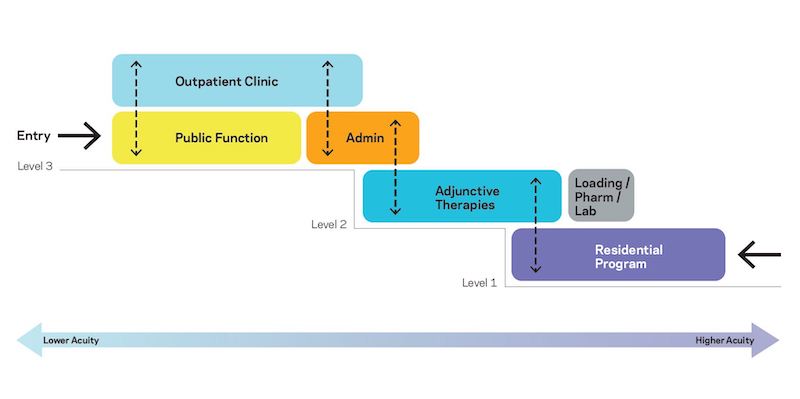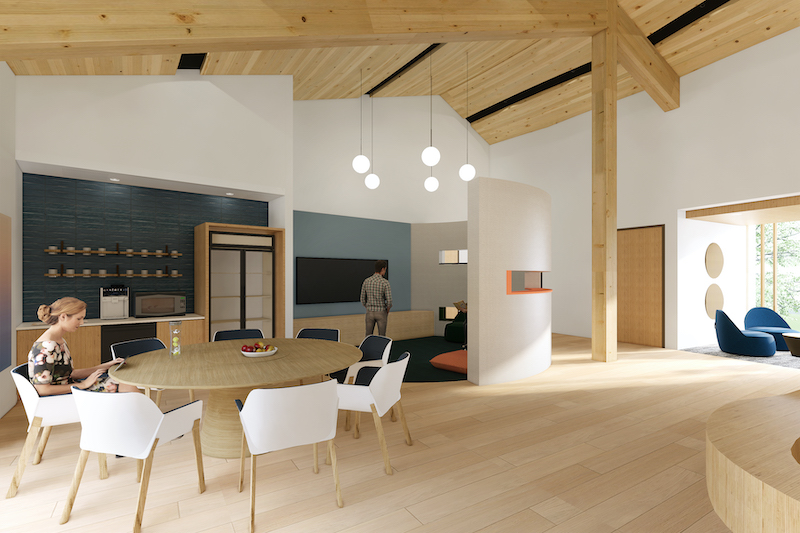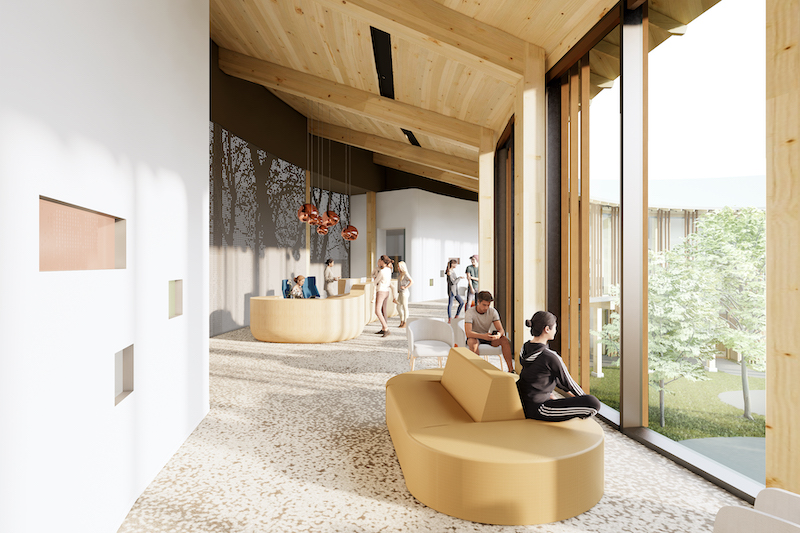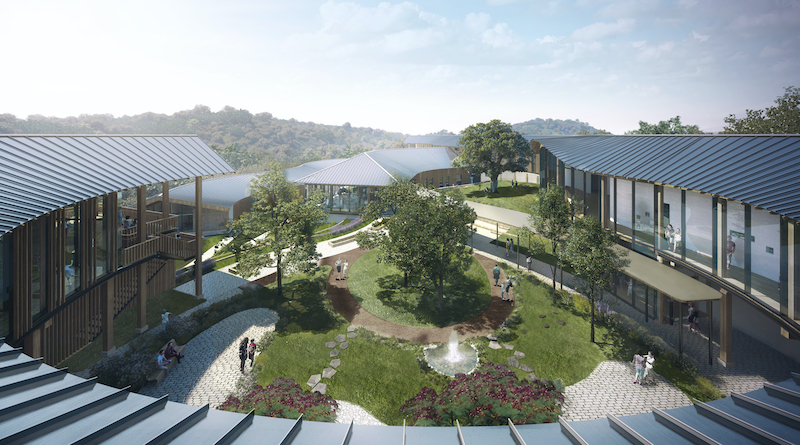A survey of 1,313 Americans ages 18 or older, which KFF Tracking conducted last July, found that more than half of those polled, 53%, reported their mental health had been negatively impacted by the coronavirus pandemic. Even before the virus started spreading, an estimated 26% of Americans suffered from diagnosable mental disorder in a given year, according to the National Institute of Mental Health Disorders.
The demand for healthcare facilities that offer mental and behavioral health services is increasing, and presents new design and construction opportunities to AEC firms.
About a year ago, on March 10, 2020, Nationwide Children’s Hospital debuted its nine-story $159 million Big Lots Behavioral Health Pavilion in Columbus, Ohio. The pavilion, designed by NBBJ and built by Turner Construction, opened as the largest pediatric facility for this specialty in the country. It has 48 inpatient beds, a psychiatric crisis department, 10 rooms for observation stays up to 24 hours, a 12-bed stabilization unit for stays up to 72 hours, and a range of outpatient treatment.

The proposed programming for the Ohana Center for Health is devised to offer a healing environment.
NBBJ also designed the 55,600-sf Ohana Center for Health in Monterey, Calif., which recently broke ground and is scheduled to open in early 2023. The project’s construction and programming are being funded by a $105.8 million donation to the Montage Health Foundation from Roberta Bialek Elliott, the sister of billionaire investor Warren Buffett. Ms. Elliott lives in Monterey and previously served on Montage Health’s Board of Trustees, according to the Chronicle of Philanthropy.
The Building Team on the Ohana Center for Health includes South Bay Construction (GC), Integral Group (MEP), Fast + Epp (SE), Whitson Engineers (CE), and BFS Landscape Architects (landscape).
BRINGING A HUMAN TOUCH TO HEALTHCARE
Jonathan Ward, FAIA, Design Partner in NBBJ’s Los Angeles office, tells BD+C that his firm’s longstanding commitment to humanizing healthcare makes it a good fit for this trend for behavioral and mental health facilities. “Before the pandemic, most of these places weren’t very nice. Now, society is destigmatizing mental health, and here is an opportunity for people to get treatment in better settings.”
“Ohana” means “family” in Hawaiian, and this venture will include everything from an actual “Ohana House” (a kind of apartment) to early intervention, comprehensive support for young people and their families, and partnerships with an extensive collection of existing community organizations.
“We envision a warm, welcoming center on Montage Health property at Ryan Ranch,” said Dr. Steven Packer, President and CEO of Montage Health. “But we see much more than bricks and mortar—a groundbreaking hub for comprehensive, innovative solutions, with concentric circles of care emanating throughout our community.”
According to Montage Health, there is a critical shortage of psychiatrists at a time when as many as one in five children ages 9 to 17 in the U.S. may have a diagnosable psychiatric disorder.
CLT USED EXTENSIVELY

The residential hub (above) and outpatient lobby (below) accentuate how cross-laminated timber is being used throughout the facility.
 NBBJ’s design for Ohana Center for Health brings together the latest in neuroscience research—Ward says his firm consulted with the brain scientist and author Dr. John Medina—to provide a healing environment for children and teenagers, as well as for caregivers who, in this field, have an annual turnover rate that exceeds 40%.
NBBJ’s design for Ohana Center for Health brings together the latest in neuroscience research—Ward says his firm consulted with the brain scientist and author Dr. John Medina—to provide a healing environment for children and teenagers, as well as for caregivers who, in this field, have an annual turnover rate that exceeds 40%.
The design immerses the Center in what Ward calls “an intentional connection to nature,” by creating a series of large outdoor cloisters, patios, and terraced spaces. Flowing water wends through the site. Prospect and refuge spaces offer privacy and natural views. Gardens with immune-boosting plants such as lavender and rosemary offer therapy and music to patients and visitors.
The Center is designed to encourage movement, which boosts the executive function of the brain in ways said to reduce mental illness. The Center will include a gym, outdoor nature trails and other forms of outside activities.
Another humanizing aspect of the design, says Ward, is its use of cross-laminated timber (CLT). This is one of the largest healthcare projects in the country to use CLT, whose modular components can be assembled offsite. The use of this composite material helps lower the facility’s carbon footprint, and will reduce materials waste during construction.
Related Stories
| Aug 16, 2022
Cedars-Sinai Urgent Care Clinic’s high design for urgent care
The new Cedars-Sinai Los Feliz Urgent Care Clinic in Los Angeles plays against type, offering a stylized design to what are typically mundane, utilitarian buildings.
| Aug 15, 2022
IF you build it, will they come? The problem of staff respite in healthcare facilities
Architects and designers have long argued for the value of respite spaces in healthcare facilities.
AEC Tech | Aug 8, 2022
The technology balancing act
As our world reopens from COVID isolation, we are entering back into undefined territory – a form of hybrid existence.
| Aug 3, 2022
Designing learning environments to support the future of equitable health care
While the shortage of rural health care practitioners was a concern before the COVID-19 pandemic, the public health crisis has highlighted the importance of health equity in the United States and the desperate need for practitioners help meet the needs of patients in vulnerable rural communities.
Healthcare Facilities | Aug 1, 2022
New Phoenix VA outpatient clinic is one of the largest veteran care facilities in the U.S.
The new Phoenix 32nd Street VA Clinic, spanning roughly 275,000 sf over 15 acres, is one of the largest veteran care facilities in the U.S.
Building Team | Jul 12, 2022
10 resource reduction measures for more efficient and sustainable biopharma facilities
Resource reduction measures are solutions that can lead to lifecycle energy and cost savings for a favorable return on investment while simultaneously improving resiliency and promoting health and wellness in your facility.
Healthcare Facilities | Jun 22, 2022
Arizona State University’s Health Futures Center: A new home for medical tech innovation
In Phoenix, the Arizona State University (ASU) has constructed its Health Futures Center—expanding the school’s impact as a research institution emphasizing medical technology acceleration and innovation, entrepreneurship, and healthcare education.
Healthcare Facilities | Jun 20, 2022
Is telehealth finally mainstream?
After more than a century of development, telehealth has become a standard alternative for many types of care.
Codes and Standards | Jun 14, 2022
Hospitals’ fossil fuel use trending downward, but electricity use isn’t declining as much
The 2021 Hospital Energy and Water Benchmarking Survey by Grumman|Butkus Associates found that U.S. hospitals’ use of fossil fuels is declining since the inception of the annual survey 25 years ago, but electricity use is dipping more slowly.
Healthcare Facilities | Jun 13, 2022
University of Kansas Health System cancer care floors foster community and empathy
On three floors of Cambridge Tower A at The University of Kansas Health System in Kansas City, patients being treated for blood cancers have a dedicated space that not only keeps them safe during immune system comprising treatments, but also provide feelings of comfort and compassion.

















